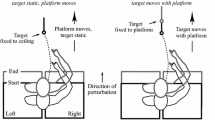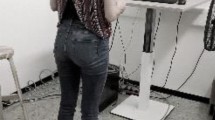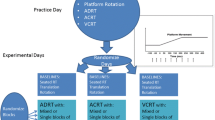Abstract
Reactive balance control following hand perturbations is important for everyday living as humans constantly encounter perturbations to the upper limb while performing functional tasks while standing. When multiple tasks are performed simultaneously, cognitive processing is increased, and performance on at least one of the tasks is often disrupted, owing to attentional resources being divided. The purpose here was to assess the effects of increased cognitive processing on whole-body balance responses to perturbations of the hand during continuous voluntary reaching. Sixteen participants (8 females; 22.9 ± 4.5 years) stood and grasped the handle of a KINARM – a robotic-controlled manipulandum paired with an augmented visual display. Participants completed 10 total trials of 100 mediolateral arm movements at a consistent speed of one reach per second, and an auditory n-back task (cognitive task). Twenty anteroposterior hand perturbations were interspersed randomly throughout the reaching trials. The arm movements with random arm perturbations were either performed simultaneously with the cognitive task (combined task) or in isolation (arm perturbation task). Peak centre of pressure (COP) displacement and velocity, time to COP displacement onset and peak, as well as hand displacement and velocity following the hand perturbation were evaluated. N-back response times were 8% slower and 11% less accurate for the combined than the cognitive task. Peak COP displacement following posterior perturbations increased by 8% during the combined compared to the arm perturbation task alone, with no other differences detected. Hand peak displacement decreased by 5% during the combined compared to the arm perturbation task. The main findings indicate that with increased cognitive processing, attentional resources were allocated from the cognitive task towards upper limb movements, while attentional resources for balance seemed unaltered.






Similar content being viewed by others
Availability of data and material
Available upon request.
Code availability
Available upon request.
References
Adkin AL, Quant S, Maki BE, McIlroy WE (2006) Cortical responses associated with predictable and unpredictable compensatory balance reactions. Exp Brain Res 172(1):85–93. https://doi.org/10.1007/s00221-005-0310-9
Allum JHJ, Carpenter MG, Adkin AL (2001) Balance control analysis as a method for screening and identifying balance deficits. Ann N Y Acad Sci 942(1):413–427. https://doi.org/10.1111/j.1749-6632.2001.tb03763.x
Allum JHJ, Carpenter MG, Honegger F, Adkin AL, Bloem BR (2002) Age-dependent variations in the directional sensitivity of balance corrections and compensatory arm movements in man. J Physiol 542(2):643–663. https://doi.org/10.1113/jphysiol.2001.015644
Andersson G, Yardley L, Luxon L (1998) A dual-task study of interference between mental activity and control of balance. Am J Otol 19(5):632–637
Bank PJM, Marinus J, van Tol RM, Groeneveld IF, Goossens PH, de Groot JH, van Hilten JJ, Meskers CGM (2018) Cognitive-motor interference during goal-directed upper-limb movements. Eur J Neurosci 48(10):3146–3158. https://doi.org/10.1111/ejn.14168
Bogost MD, Burgos PI, Little CE, Woollacott MH, Dalton BH (2016) Electrocortical sources related to whole-body surface translations during a single-and dual-task paradigm. Front Hum Neurosci 10:524
Braver TS, Cohen JD, Nystrom LE, Jonides J, Smith EE, Noll DC (1997) A parametric study of prefrontal cortex involvement in human working memory. Neuroimage 5(1):49–62
Broeder S, Nackaerts E, Nieuwboer A, Smits-Engelsman BCM, Swinnen SP, Heremans E (2014) The effects of dual tasking on handwriting in patients with Parkinson’s disease. Neuroscience 263:193–202. https://doi.org/10.1016/j.neuroscience.2014.01.019
Brown LA, Shumway-Cook A, Woollacott MH (1999) Attentional demands and postural recovery: the effects of aging. J Gerontol Series A 54(4):M165–M171
Carpenter MG, Allum JH, Honegger F (1999) Directional sensitivity of stretch reflexes and balance corrections for normal subjects in the roll and pitch planes. Exp Brain Res 129(1):93–113
Carpenter MG, Frank JS, Silcher CP, Peysar GW (2001) The influence of postural threat on the control of upright stance. Exp Brain Res 138(2):210–218
Dierijck J, Kennefick M, Smirl J, Dalton BH, van Donkelaar P (2020) Attention is required to coordinate reaching and postural stability during upper limb movements generated while standing. J Mot Behav 52(1):79–88. https://doi.org/10.1080/00222895.2019.1587351
Dietz V, Quintern J, Berger W (1984) Cerebral evoked potentials associated with the compensatory reactions following stance and gait perturbation. Neurosci Lett 50(1):181–186. https://doi.org/10.1016/0304-3940(84)90483-X
Dietz V, Quintern J, Berger W, Schenck E (1985) Cerebral potentials and leg muscle emg responses associated with stance perturbation. Exp Brain Res 57(2):348–354
Horak FB, Nashner LM (1986) Central programming of postural movements: adaptation to altered support-surface configurations. J Neurophysiol 55(6):1369–1381. https://doi.org/10.1152/jn.1986.55.6.1369
Horak FB, Nashner LM, Diener HC (1990) Postural strategies associated with somatosensory and vestibular loss. Exp Brain Res 82(1):167–177. https://doi.org/10.1007/BF00230848
Huxhold O, Li SC, Schmiedek F, Lindenberger U (2006) Dual-tasking postural control: aging and the effects of cognitive demand in conjunction with focus of attention. Brain Res Bull 69(3):294–305
Kahneman D (1973) Attention and effort. Prentice-Hall, Englewood Cliffs
Kennefick M, Wright AD, Smirl JD, van Donkelaar P (2018) Anticipatory postural adjustments as a function of response complexity in simple reaction time tasks. Neurosci Lett 684:1–5
Kerr B, Condon SM, McDonald LA (1985) Cognitive spatial processing and the regulation of posture. J Exp Psychol Hum Percept Perform 11(5):617
Kirchner WK (1958) Age differences in short-term retention of rapidly changing information. J Exp Psychol 55(4):352
Lajoie Y, Teasdale N, Bard C, Fleury M (1993) Attentional demands for static and dynamic equilibrium. Exp Brain Res 97(1):139–144
Lin S, Woollacott MH (2002) Postural muscle responses following changing balance threats in young, stable older, and unstable older adults. J Mot Behav 34(1):37–44. https://doi.org/10.1080/00222890209601929
Little CE, Woollacott M (2014) Effect of attentional interference on balance recovery in older adults. Exp Brain Res 232(7):2049–2060
Little CE, Woollacott M (2015) EEG measures reveal dual-task interference in postural performance in young adults. Exp Brain Res 233(1):27–37
Lowrey C, Nashed J, Scott S (2017) Rapid and flexible whole body postural responses are evoked from perturbations to the upper limb during goal-directed reaching. J Neurophysiol 117(3):1070–1083. https://doi.org/10.1152/jn.01004.2015
Maki BE, McIlroy WE (2007) Cognitive demands and cortical control of human balance-recovery reactions. J Neural Transm 114(10):1279–1296
Massion J (1998) Postural control systems in developmental perspective. Neurosci Biobehav Rev 22(4):465–472
McGeehan MA, Woollacott MH, Dalton BH (2017) Vestibular control of standing balance is enhanced with increased cognitive load. Exp Brain Res 235(4):1031–1040
Monk AF, Jackson D, Nielsen D, Jefferies E, Olivier P (2011) N-backer: an auditory n-back task with automatic scoring of spoken responses. Behav Res Methods 43(3):888
Nashner LM (1976) Adapting reflexes controlling the human posture. Exp Brain Res 26(1):59–72. https://doi.org/10.1007/BF00235249
Norrie RG, Maki BE, Staines WR, McIlroy WE (2002) The time course of attention shifts following perturbation of upright stance. Exp Brain Res 146(3):315–321
Pellecchia GL (2003) Postural sway increases with attentional demands of concurrent cognitive task. Gait Posture 18(1):29–34
Peterka RJ (2002) Sensorimotor integration in human postural control. J Neurophysiol 88(3):1097–1118. https://doi.org/10.1152/jn.2002.88.3.1097
Quant S, Adkin AL, Staines WR, Maki BE, McIlroy WE (2004) The effect of a concurrent cognitive task on cortical potentials evoked by unpredictable balance perturbations. BMC Neurosci 5(1):18
Quant S, Maki BE, McIlroy WE (2005) The association between later cortical potentials and later phases of postural reactions evoked by perturbations to upright stance. Neurosci Lett 381(3):269–274
Rasman BG, Forbes PA, Tisserand R, Blouin JS (2018) Sensorimotor manipulations of the balance control loop–beyond imposed external perturbations. Front Neurol 9:899
Redfern MS, Müller ML, Jennings JR, Furman JM (2002) Attentional dynamics in postural control during perturbations in young and older adults. J Gerontol A Biol Sci Med Sci 57(8):B298–B303
Santos MJ, Kanekar N, Aruin AS (2010a) The role of anticipatory postural adjustments in compensatory control of posture: 1. Electromyographic analysis. J Electromyogr Kinesiol 20(3):388–397
Santos MJ, Kanekar N, Aruin AS (2010b) The role of anticipatory postural adjustments in compensatory control of posture: 2. Biomechanical analysis. J Electromyogr Kinesiol 20(3):398–405
Shumway-Cook A, Woollacott M (2000) Attentional demands and postural control: the effect of sensory context. J Gerontol A Biol Sci Med Sci 55(1):M10-16
Smith CP, Allsop JE, Mistry M, Reynolds RF (2017) Co-ordination of the upper and lower limbs for vestibular control of balance. J Physiol 595(21):6771–6782
Stamenkovic A, Stapley PJ, Robins R, Hollands MA (2018) Do postural constraints affect eye, head, and arm coordination? J Neurophysiol 120(4):2066–2082
Stoffregen TA, Smart LJ, Bardy BG, Pagulayan RJ (1999) Postural stabilization of looking. J Exp Psychol 25(6):1641–1658. https://doi.org/10.1037/0096-1523.25.6.1641
Stoffregen TA, Pagulayan RJ, Bardy BG, Hettinger LJ (2000) Modulating postural control to facilitate visual performance. Hum Mov Sci 19(2):203–220. https://doi.org/10.1016/S0167-9457(00)00009-9
Swan L, Otani H, Loubert PV, Sheffert SM, Dunbar GL (2004) Improving balance by performing a secondary cognitive task. Br J Psychol 95(1):31–40
Trivedi H, Leonard JA, Ting LH, Stapley PJ (2010) Postural responses to unexpected perturbations of balance during reaching. Exp Brain Res 202(2):485–491. https://doi.org/10.1007/s00221-009-2135-4
Wickens CD (1983) Processing resources in attention, dual task performance and workload assessment. In: Parasuraman R, Davies R (eds) Varieties of attention. Academic Press, New York, pp 63–102
Winter DA (1995) Human balance and posture control during standing and walking. Gait Posture 3(4):193–214
Winter DA, Patla AE, Prince F, Ishac M, Gielo-Perczak K (1998) Stiffness control of balance in quiet standing. J Neurophysiol 80(3):1211–1221
Woollacott M, Shumway-Cook A (2002) Attention and the control of posture and gait: a review of an emerging area of research. Gait Posture 16(1):1–14
Woollacott M, Vander Velde T (2008) Non-visual spatial tasks reveal increased interactions with stance postural control. Brain Res 1208:95–102
Wulf G, McNevin N, Shea CH (2001) The automaticity of complex motor skill learning as a function of attentional focus. Q J Exp Psychol Sect A 54(4):1143–1154
Yardley L, Gardner M, Leadbetter A, Lavie N (1999) Effect of articulatory and mental tasks on postural control. NeuroReport 10(2):215–219
Acknowledgements
The authors would like to thank the participants who volunteered in this study. Operating funds for this study were provided through a Discovery Grant from the Natural Sciences and Engineering Research Council of Canada (2017-06632) and infrastructure was supported by the Canada Foundation for Innovation (30979).
Funding
This work was supported by the Natural Sciences and Engineering Research Council of Canada (2017-06632) and the Canada Foundation for Innovation (30979).
Author information
Authors and Affiliations
Contributions
M.T. conceived the study concept, collected and analyzed data, wrote the first draft of the manuscript and edited the manuscript. B.H.D. conceived the study concept, helped with data analysis, collection and interpretation, and reviewed and edited the manuscript. M.K. helped conceive and design experimental design, helped with interpretation of data, and reviewed and edited the manuscript. S.C. helped with data collection and analysis as well as reviewing and editing the manuscript. P.v.D. helped with data interpretation, experimental design as well as reviewing and editing the manuscript. All authors approved the submitted version of the manuscript and agree to be accountable for all aspects of the work.
Corresponding author
Ethics declarations
Conflict of interest
The authors have no relevant financial or non-financial interests to disclose.
Ethical Approval
This study was performed in line with the Canada's Tri-Council Policy Statement on Ethical Conduct for Research Involving Humans. The study procedures were approved by the University of British Columbia’s Clinical Research Ethics Board (No. H19-01982).
Consent to participate
All participants included in the study provided oral and written informed consent.
Consent for publication
Not applicable.
Additional information
Communicated by Francesco Lacquaniti.
Publisher's Note
Springer Nature remains neutral with regard to jurisdictional claims in published maps and institutional affiliations.
Rights and permissions
About this article
Cite this article
Trotman, M., Kennefick, M., Coughlin, S. et al. The effect of increased cognitive processing on reactive balance control following perturbations to the upper limb. Exp Brain Res 240, 1317–1329 (2022). https://doi.org/10.1007/s00221-022-06326-6
Received:
Accepted:
Published:
Issue Date:
DOI: https://doi.org/10.1007/s00221-022-06326-6




